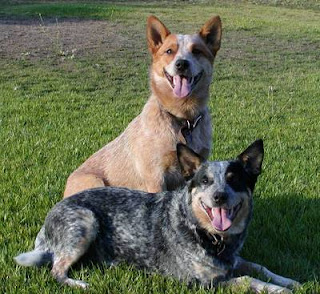 Like many working dogs, the Australian Cattle Dog has high energy levels, an active mind, and a level of independence.The breed ranks 10th in Stanley Coren's The Intelligence of Dogs, rated as one of the most intelligent dogs ranked by obedience command trainability.[9] The Cattle Dog needs plenty of exercise, companionship and a job to do, so a non-working dog might participate in dog sports, learning tricks, or other activities that engage its body and mind.
Like many working dogs, the Australian Cattle Dog has high energy levels, an active mind, and a level of independence.The breed ranks 10th in Stanley Coren's The Intelligence of Dogs, rated as one of the most intelligent dogs ranked by obedience command trainability.[9] The Cattle Dog needs plenty of exercise, companionship and a job to do, so a non-working dog might participate in dog sports, learning tricks, or other activities that engage its body and mind.When on home ground, the Australian Cattle Dog is a happy, affectionate, and playful pet.However, it is reserved with people it does not know and naturally cautious in new situations. Its attitude to strangers makes it an excellent guard dog when trained for this task, and it can be socialised to become accustomed to a variety of people from an early age as a family pet. It is good with older, considerate children, but will herd people by nipping at their heels, particularly younger children who run and squeal.By the time puppies are weaned, they should have learned that the company of people is pleasurable, and that responding to cues from a person is rewarding.The bond that this breed can create with its owner is strong and will leave the dog feeling protective towards the owner, typically resulting in the dog's never being too far from the owner's side. The Australian Cattle Dog can be the friendliest of companions although it is quick to respond to the emotions of its owners, and may defend them without waiting for a command.The ACD was originally bred to move reluctant cattle by biting, and it will bite if treated harshly.[10] The Australian Cattle Dog's protective nature and tendency to nip at heels can be dangerous as the dog grows into an adult if unwanted behaviours are left unchecked.
While an Australian Cattle Dog generally works silently, it will bark in alarm or to attract attention. It has a distinctive intense, high-pitched bark. Barking can be a sign of boredom or frustration, although research has shown that pet dogs increase their vocalisation when raised in a noisy environment.It responds well to familiar dogs, but when multiple dogs are present, establishing a pecking order can trigger aggression. It is not a breed that lives in a pack with other dogs.
Data accumulated from Council reports in New South Wales from 2004-2005 showed that dogs identified as Australian Cattle Dogs were involved in more attacks than any other breed except the German Shepherd, where an attack is defined as any incident where a dog rushes at, bites, harasses or chases any person or animal. Fourteen other breeds were involved in incidents. Expressed as a percentage of registered dogs, 0.1% of Australian Cattle Dogs were involved in attacks.The data gathered in 2011-2012 listed the Australian Cattle dog twenty-seventh in involvement in incidents ranked by percentage of dogs registered. A review of incidents in Melbourne where a dog bit, rushed at or chased a person or animal in a public space, found that there were sixty breeds involved and the German Shepherd and German Shepherd crosses, and Australian Cattle Dog and Cattle Dog crosses accounted for 9% of incidents.Surveys of U.S. breed club members showed that both dog-directed aggression and stranger-directed aggression were higher in the ACD than the average of breeds studied, with dog-directed aggression being the more prevalent of the two aggression types.The American Temperament Test Society reports a test pass rate of 79.3% for Australian Cattle Dogs.The average pass rate for all breeds combined is 80.4%.
Data refer : http://en.wikipedia.org/wiki/Australian_Cattle_Dog



